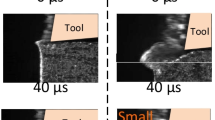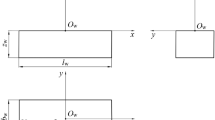Abstract
Abrasive reaming is a low-speed grinding process, which has been applied in precision machining of fuel nozzle holes of aero-engine. The burrs produced in abrasive reaming always have a great influence on the machining quality. In order to investigate the burr formation mechanism in abrasive reaming, a micro-cutting model of the single-particle abrasive was developed to simulate side burr formation. The model simplified the operation of abrasive reaming process and transformed the helical motion into the linear motion of the abrasive grains. The simulation results were also verified experimentally. The side burrs were characterized by four parameters, e.g., the side burr cross-sectional area S, the burr thickness bg, the burr height h0, and the burr root thickness br. The effects of the position (i.e., the entrance and exit of the nozzle), cutting speed, cutting-edge inclination, cutting depth, and cutting width on the side burrs were discussed. Accordingly, the formation mechanism of side burrs was explored based on the simulation results of single-particle abrasive micro-cutting behavior. Finally, the optimum processing parameters were obtained as follows: cutting speed vs = 0.4 m/s, cutting-edge inclination angle λs = −60°, minor cutting depth aps = 2 μm each time, and little cutting width bps = 2 μm each time. Under such condition, the burr is tiny in thickness, short in length, and easy to be dislodged.

































Similar content being viewed by others
Data availability
All data generated or analyzed during this study are included in the present article.
References
Fei Z, Wang KC, Wang H, Xiao YQ (2018) The inner-cone angle measurement of aero-engine nozzle based on conoscopic holography. Optik 169:416–423
Dong PC, Tang HL, Chen M, Zou ZP (2018) Overall performance design of paralleled heat release and compression system for hypersonic aeroengine. Appl Energy 220:36–46
Burkhard G, Rehsteiner F, Schumacher B (2002) High efficiency abrasive tool for honing. CIRP Ann 51(1):271–274
Arunachalam S, Gunasekaran A, O'Sullivan JM (1999) Analysing the process behaviour of abrasive reaming using an experimental approach. Int J Mach Tools Manuf 39(8):1311–1325
Kholmogortsev PY (2009) Optimizing the diamond reaming of precision holes. Russ Eng Res 29(4):375–382
Persson H, Agmell M, Bushlya V, Ståhl JE (2017) Experimental and numerical investigation of burr formation in intermittent turning of AISI 4140. Procedia CIRP 58:37–42
Chen MJ, Ni HB, Wang ZJ, Jiang Y (2012) Research on the modeling of burr formation process in micro-ball end milling operation on Ti-6Al-4V. Int J Adv Manuf Technol 62(9-12):901–912
Gaitonde VN, Karnik SR, Achyutha BT, Siddeswarappa B (2007) Methodology of Taguchi optimization for multi-objective drilling problem to minimize burr size. Int J Adv Manuf Technol 34(1-2):1–8
Aurich JC, Sudermann H, Bil H (2005) Characterisation of burr formation in grinding and prospects for modelling. CIRP Ann Manuf Technol 54(1):313–316
Fu DK, Ding WF, Yang SB, Miao Q, Fu YC (2017) Formation mechanism and geometry characteristics of exit-direction burrs generated in surface grinding of Ti-6Al-4V titanium alloy. Int J Adv Manuf Technol 89:2299–2313
Aurich JC, Dornfeld DA, Arrazola PJ, Frankea V, Leitz L, Min S (2009) Burrs-analysis, control and removal. CIRP Ann Manuf Technol 58(2):519–542
Aurich JC, Sudermann H, Braun O (2006) Experimental investigation of burr formation in the surface grinding of tool steel. Proc Inst Mech Eng B J Eng Manuf 220(4):489–497
Wang GC, Zhang CY (2004) Study on the forming mechanism of the cutting-direction burr in metal cutting. Key Eng Mater 259-260:868–860
Kim J, Min S, Dornfeld DA (2001) Optimization and control of drilling burr formation of AISI 304L and AISI 4118 based on drilling burr control charts. Int J Mach Tools Manuf 41(7):923–936
International Standard ISO 13715:2000, Technical drawings - edges of undefined shape - vocabulary and indications
Schäfer F (1975) Entgraten. Krausskopfverlag, Mainz
Gillespie LK (1999) Deburring and edge finishing handbook. Society of Manufacturing Engineers
Sudermann H, Reichenbach IG, Aurich JC (2010) Analytical modeling and experimental investigation of burr formation in grinding. Burrs Anal Control Removal 2010:63–71
Dong DP, Song JB, Yu DD, Chen M (2015) Finite element analysis of burr formation and an automatic online micro-deburring method in precise end-face grinding process. Proc Inst Mech Eng B J Eng Manuf 231(14):2495–2503
Min S, Dornfeld DA, Jinsoo K, Shyu B (2001) Finite element modeling of burr formation in metal cutting. Mach Sci Technol 5(3):16
Aurich JC, Sudermann H, Bil H (2006) 3D finite element modeling of burr formation in grinding. Proceedings of the 9th CIRP International Workshop on Modeling of Machining Operations Bled, Slovenia, 47-50
Lauderbaugh LK (2009) Analysis of the effects of process parameters on exit burrs in drilling using a combined simulation and experimental approach. J Mater Process Technol 209(4):1909–1919
Aziz M, Ohnishi O, Onikura H (2012) Advanced burr-free hole machining using newly developed micro compound tool. Int J Precis Eng Manuf 13(6):947–953
Schloemer TH, Christians JA, Luther JM, Sellinger A (2019) Doping strategies for small molecule organic hole-transport materials: impacts on perovskite solar cell performance and stability. Chem Sci 10(7):1–65
Guo YB, Dornfeld DA (2000) Finite element modeling of burr formation process in drilling 304 stainless steel. J Manuf Sci Eng 122(4):612–620
De Souza AM, Sales WF, Ezugwu EO, Bonney J, Machado AR (2003) Burr formation in face milling of cast iron with different milling cutter systems. Proc Inst Mech Eng B J Eng Manuf 217(11):1589–1596
Basavarajappa S, Chandramohan G, Ashwin M, Prabu M, Mukund K (2006) Analysis of burr formation during drilling of hybrid metal matrix composites using design of experiments. Int J Mach Mach Mater 1(4):53–64
Ahn Y, Lee SH (2016) Classification and prediction of burr formation in micro drilling of ductile metals. Int J Prod Res 2016:1–14
Chen MJ, Liang YC, Yuan YJ, Dan L (2008) Deposition mechanism of nano-structured single-layered C36 film on a diamond (100) crystal plane. Chin Phys B 17(11):4260
Johnson GR, Cook WH (1985) Fracture characteristics of three metals subjected to various strains, strain rates, temperatures and pressures. Eng Fract Mech 21(1):31–48
Umbrello D, Saoubib RM, Outeiroc JC (2007) The influence of Johnson-Cook material constants on finite element simulation of machining of AISI 316L steel. Int J Mach Tools Manuf 47:462–470
Meyers MA (1994) Dynamic behavior of materials. John Wiley and Sons, New York
Zhang LN, Li PN, Tang SW, Tang WB, Zhang S (2014) Mechanical behaviors analysis and Johnson-Cook model establishment of 4Cr13 Stainless Steel. Key Eng Mater 589-590:45–51
Dai CW, Ding WF, Xu JH, Fu YC, Yu TY (2017) Influence of grain wear on material removal behavior during grinding nickel-based superalloy with a single diamond grain. Int J Mach Tools Manuf 113:49–58
ASM Metals Handbook, Vol 01: Properties and selection: irons, steels, and high-performance alloys
Funding
This work was funded by the National Natural Science Foundation of China (No. 52075252).
Author information
Authors and Affiliations
Contributions
Changyong Yang conceived the analysis and wrote the manuscript. Jianzhong Huang collected the data and revised the manuscript. Shaowu Gao performed the experiment. Jiuhua Xu, Wenfeng Ding, and Yucan Fu provided supervision on experimentation and manuscript preparation.
Corresponding author
Ethics declarations
Ethics approval and consent to participate
The article follows the guidelines of the Committee on Publication Ethics (COPE) and involves no studies on human or animal subjects.
Consent for publication
Not applicable.
Competing interests
The authors declare that they have no competing interests.
Additional information
Publisher’s note
Springer Nature remains neutral with regard to jurisdictional claims in published maps and institutional affiliations.
Rights and permissions
About this article
Cite this article
Yang, C., Huang, J., Xu, J. et al. Investigation on formation mechanism of the burrs during abrasive reaming based on the single-particle abrasive micro-cutting behavior. Int J Adv Manuf Technol 113, 907–921 (2021). https://doi.org/10.1007/s00170-021-06687-2
Received:
Accepted:
Published:
Issue Date:
DOI: https://doi.org/10.1007/s00170-021-06687-2




